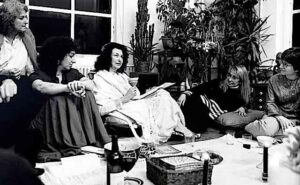
Spring is officially here as evidenced by the appearance of the first flowers breaking through the ground and buds on trees. Passover, celebrated from the evening of April 12 until April 20, is one of the three Jewish festivals (Shavuot and Sukkot are the others). These festivals each had an agricultural element and were observed by pilgrimage to the ancient Temple in Jerusalem. While one of Passover’s names is Hag Ha-Aviv (the Festival of Spring), it is better known and observed as the festival commemorating the Exodus of the Israelites from Egyptian bondage (described in the Biblical Book of Exodus). The Torah sets up Passover (from the first one observed while leaving Egypt) as an unusual inter-generational conversation of meaning-making. This process continues today: the book used to guide this process is itself called Haggadah, the (Re)Telling. One of the ways it guides us to do so is through the Four Children which is based on four different times in the Torah that describe children asking questions and/or receiving instruction about the Exodus. As former British Chief Rabbi Jonathan Sachs (of blessed memory) teaches:
Rather than seeing these as just four examples of asking the same question, the Rabbis noticed four distinctive personalities from the different ways the verses are phrased – and this inspired the idea for four kinds of children.
The four children are a vignette of the Jewish people. One asks because he wants to hear the answer. A second asks because he does not want to hear the answer. A third asks because he does not understand. The fourth does not ask because he doesn’t understand that he doesn’t understand. Ours has never been a monolithic people.*
This is one way that the Haggadah acknowledges the importance of Jews coming together even when they have serious differences of thought and observance. The Haggadah text encourages us to personalize and contextualize the process of finding meaning in the Exodus: “In every generation one is obligated to see oneself as one who personally went out of Egypt… Not only were our ancestors redeemed by the Holy One, but even we were redeemed with them.” This text highlights that the meaning making of Passover is ongoing, comprised of individuals who together create a collective.
For over a year, I have been learning the Babylonian Talmud tractate Pesachim which explores the holiday’s laws in depth. Over and over, it emphasizes that Passover is universal and finds creative ways to include as many people in its observance who would not be able to participate in other Temple rituals.
So, please take this as an opportunity to join us in Seders on campus. See flyers in this newsletter for more opportunities. One of the first texts opens the Seder to everyone, exclaiming: “All who are hungry, come and eat.” Hunger can be for the process of opening ourselves and not just for food. ‘All’ includes those of any faith and whatever your thoughts are about Judaism, Israel/Palestine, or any other political or social issue.

Like last year, we are trying hard to make Passover welcoming to all. Please join us with a desire to learn from each other as we share the experience of renewal and liberation.
Photo depicts participants at a 1976 Women’s Seder (including Letty Cotton Pogrebin, a founder of Ms. Magazine, second from right, and at far right, Martha Ackelsberg, PhD, Smith Professor Emerita of Government and of the Study of Women & Gender).
If you have not done so, sign up here for meals and First Night Seder.
Happy Passover! Happy spring!
*It is only in the last thirtyish years that any printed text called the Four Children anything but Sons. Rabbi Sachs is inclusive in his use of ‘Children’ but then uses only masculine pronouns. This may be unconscious bias on his part or just reflects Hebrew’s use of masculine for indefinite pronouns.
This article was written by Rabbi Bruce Bromberg Seltzer, Smith’s Jewish Student Advisor.
